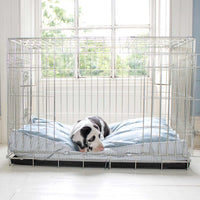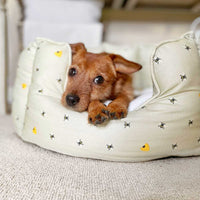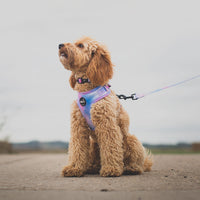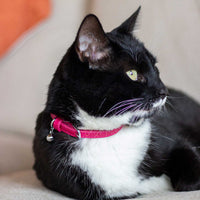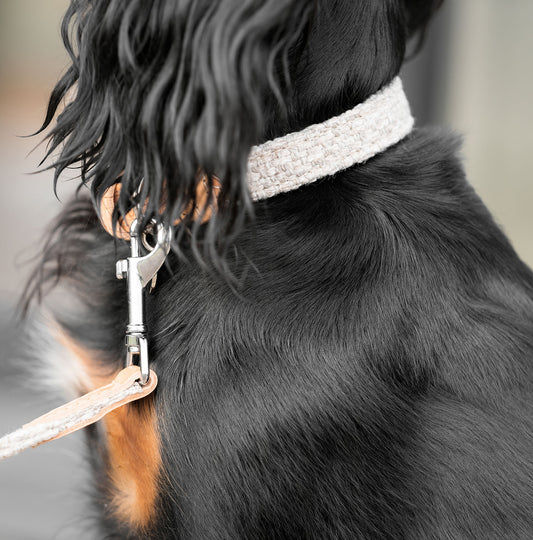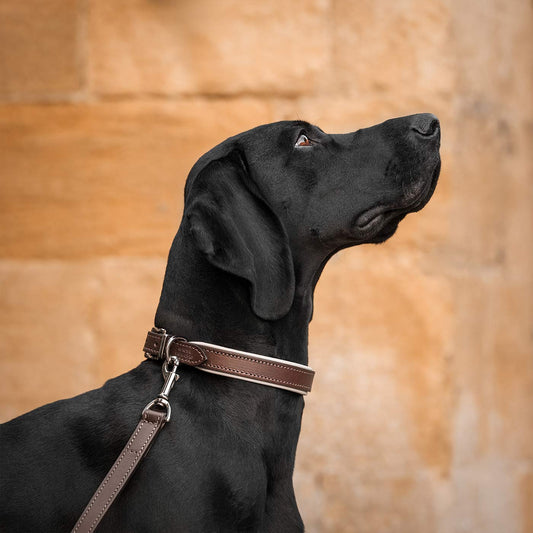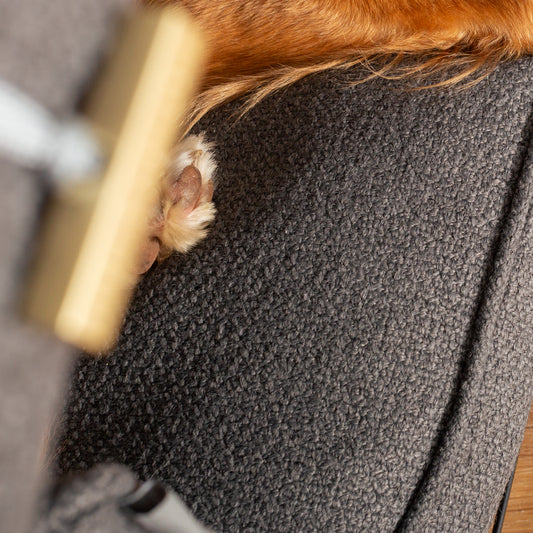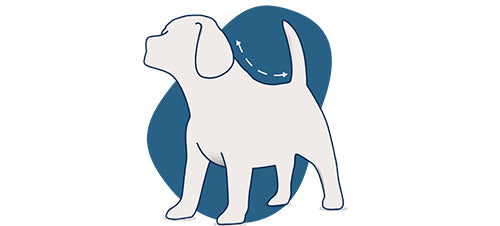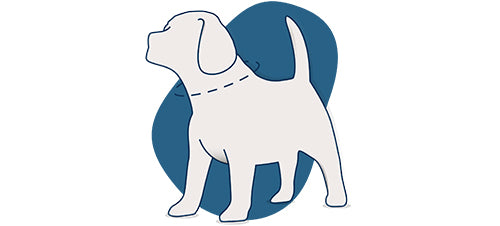A walk is one of your dog’s favourites parts of the day, however, choosing the right equipment is crucial for a comfortable and safe experience. The primary debate for many dog owners is whether to use a harness or a collar. Each option has its own advantages and disadvantages, and the best choice often depends on your dog’s breed, size, health, and behaviour. In this article, our Pet Experts explore the differences between harnesses and collars to help you make an informed decision.
Harness vs Collar: What’s the Difference?
A harness is designed to distribute pressure evenly across a dog’s chest and back, while a collar sits around the neck. This fundamental difference in design means that each has distinct impacts on your dog’s comfort and health.
Dog Harnesses

Advantages of Using a Harness
- Better Control: Harnesses provide more control, especially for larger or more energetic dogs. They are ideal for training and managing dogs that tend to pull on the lead.
- Reduced Risk of Injury: By distributing pressure across the chest, a harness reduces the risk of neck injuries. This is particularly important for breeds prone to respiratory problems or those with a delicate trachea, such as Pugs or Yorkshire Terriers.
- Prevents Escaping: A well-fitted harness can prevent dogs from slipping out, which is a common issue with collars. This added security is beneficial for dogs that are known escape artists.
- Versatility: Many harnesses come with additional features like handles for extra control, or reflective strips for better visibility during nighttime walks.
Disadvantages of Using a Harness
- Complexity: Harnesses can be more complicated to put on and take off compared to collars. This can be a hassle for both the dog and the owner if the dog is particularly fidgety
- Dislike: Not all dog’s like the sensation of having a harness put over their head, however getting them used to a harness early can help with this.
- Comfort: If not properly fitted, a harness can cause chafing or discomfort. It's essential to ensure that the harness is the right size and adjusted correctly.
- Limited Styles: While harnesses come in various designs, they may not offer the same stylish options as collars, which can be a consideration for those who like their pets to make a fashion statement.
Our Top 3 Harnesses
Here at Lords & Labradors we put a lot of time into sourcing the best walking accessories for your pup. We want them to be both practical and stylish, here are our top 3 harnesses.
- Ruffwear Front Range Harness: The Ruffwear Front Range Harness allows you to enjoy your outdoor adventures with your favourite canine companion wherever you're going. It has 4 points of adjustment allowing full range of motion. The Front Range harness also has clips on both the front and back allowing you more control over your dog and helps to distribute any pressure more evenly when your dog pulls.
- Cocopup NAKD Harness: The Cocopup Nakd Harness fuses style and practicality together. It comes in seven stylish colours and has matching collars and leads available. With adjustable neck and chest straps, a safety locking feature, and 4 sizes to choose from, you can be sure to find the perfect fit for your pup. The clasps also have a safety locking feature which is great for any pups who have a habit of escaping their harness.
- Barbour Travel and Exercise Harness: The Barbour Travel & Exercise Dog Harness seamlessly blends comfort and safety, making it an ideal choice for both exercise and travel. Crafted by Barbour, this harness features a padded chest and adjustable straps to ensure a secure and comfortable fit for your dog. The reflective piping enhances visibility during nighttime walks, providing peace of mind, while the integrated car seatbelt loop keeps your pup secure during car journeys. The harness also features Barbour's iconic tartan pattern which you can match to your own Barbour quilted jacket, so you and your pup can be the most stylish pair in the park.
Dog Collars

Advantages of Using a Collar
- Simplicity: Collars are straightforward to put on and take off, making them convenient for daily use.
- Identification: Collars can hold ID tags, making it easier to identify your dog if they get lost. Some harnesses have this feature, but collars are typically more reliable for this purpose.
- Training: Collars can be useful for training purposes, particularly for dogs that respond well to quick corrections.
- Variety: Collars come in a wide range of styles, colours, and materials, allowing for personalisation and fashion-forward choices.
Disadvantages of Using a Collar
- Risk of Injury: Collars can cause neck injuries, especially if the dog pulls hard or if sudden pressure is applied. This is a significant concern for dogs with delicate necks or those prone to respiratory issues.
- Limited Control: Collars do not provide the same level of control as harnesses, making them less effective for managing stronger dogs who like to pull.
- Choking Hazard: Dogs that pull on the lead can experience choking or discomfort with collars, potentially leading to negative associations with walking.
Our Top 3 Collars
- Lords & Labradors Essentials Collars: Our Essentials Twill and Herdwick collars are the perfect lightweight collar. They are available in 7 sizes and are handcrafted in Italy. Featuring sturdy silver hardware and leather accents, these collars are a durable choice for your pup. Whether you pick the bobbly woven texture of Herdwick or the lovely linen texture of Twill, your dog will be stepping out in style with our Essentials collars.
- Lords & Labradors Italian Padded Leather Collars: Our padded leather collars are consciously hand crafted in Italy, using the finest Italian leather. They come in six sizes and have a soft padding round the inside of the collar making them super comfy for your dog. These are a great choice, paired with our leads it’s sure to look stylish
- Dogs & Horses Soft Rolled Leather Collar: Made from a butter soft leather, these rolled collars are a great choice for long haired dogs as the rolled shape stops the hair from matting. These collars are made using heritage craftsmanship here in England and are available in a large range of both sizes and colours.
Collar or Harness for Dog Walking: Making the Right Choice

When deciding between a dog harness vs collar, consider your dog’s specific needs and behaviours. Here are some factors to keep in mind:
- Breed and Size: Larger breeds or those with respiratory issues may benefit more from a harness. Smaller breeds with less pulling power may do well with a collar.
- Health Conditions: Dogs with neck or spinal issues should avoid collars to prevent further injury. A harness can provide a safer option.
- Training Needs: If your dog is still learning lead manners, a harness can offer better control and reduce the risk of injury. For well-trained dogs, a collar may suffice.
- Activity Level: Active dogs that participate in sports or outdoor adventures may need the added security and control of a harness.
Is a Harness Better Than a Collar?
Ultimately, whether a harness or collar is better depends on your dog. For most dog owners, a harness is often the more practical choice, particularly for walks and outdoor activities. However, collars remain a convenient and stylish option for everyday use, especially when fitted with ID tags for quick identification, and some dogs do walk better with a collar rather than a harness. This is one of them things that has no right answer, it will ultimately come down to what suits your lifestyle and which your dog walks better with.
In conclusion, both harnesses and collars have their place in a dog’s wardrobe. By understanding the pros and cons of each, you can make an informed decision that best suits your dog's needs and lifestyle. Whether you choose a harness or collar, the most important factor is ensuring that your dog is comfortable, safe, and happy during your walks together.
Here at Lords & Labradors we have a wide range of designer walking accessories, with both luxurious and practical options to suit every dog’s unique needs. Shop our collection here.

























































